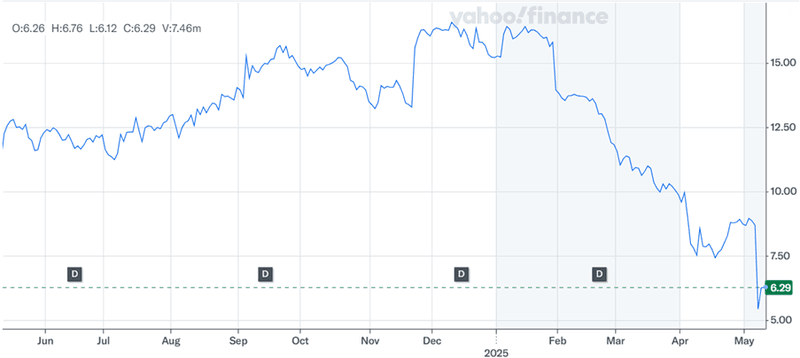Vestis Takeover War Brews As Advent, Apollo & Clayton Dubilier Circle The Struggling Giant!

Vestis (NYSE:VSTS), a major player in the uniform and workplace supplies sector, has found itself in the spotlight after media reports revealed that prominent private equity firms—including Advent International, Apollo Global, and Clayton Dubilier & Rice—have submitted preliminary bids for the company. The timing is intriguing: these acquisition interests follow French competitor Elis pulling out of takeover talks last October and come just as Vestis undergoes a leadership transition with Jim Barber, former UPS COO, stepping in as CEO on June 2, 2025. Though the company posted a 5.7% year-over-year decline in Q2 revenue, management emphasized that several operational improvements are already reversing the trend, with average weekly revenue showing consistent month-over-month growth. Let us take a closer look at the company and analyze the biggest factors drawing interest from top-tier buyout shops.
Leadership Overhaul Signals Strategic Realignment
The announcement that Jim Barber, former Chief Operating Officer of UPS, will take over as CEO reflects a strategic pivot that strengthens investor confidence. Barber’s tenure at UPS was defined by a focus on operational efficiency and scalable growth—two areas that Vestis urgently needs to address. With current Chairman Phillip Holloman returning to a board-only role, the move ensures a clean transition of power and clarifies operational accountability. Barber’s global logistics background aligns well with Vestis’ need for better inventory control, service reliability, and plant-level execution. Furthermore, recent executive additions—such as a revamped sales leadership and an experienced COO—are aimed at overhauling core operations, a critical prerequisite for stabilizing customer relationships. This transition phase, often preferred by private equity firms, enables incoming management to reset the company’s operating playbook, streamline costs, and reposition Vestis in an otherwise fragmented market. A strong leadership bench reduces integration risk post-acquisition and makes the business more valuable from a turnaround and growth perspective.
Recurring Revenue Model With Embedded Operating Leverage
Despite short-term volatility, Vestis operates a highly repeatable business model anchored in long-term rental contracts for uniforms and workplace supplies. In Q2 2025, $17 million in new rental business was secured—accounting for 2.4% of quarterly revenue—which helped offset $20 million in lost accounts. Notably, recurring revenue installations grew 35% year-over-year, suggesting the foundation for top-line stability is strengthening. Vestis’ cost base is largely fixed, as seen by the EBITDA margin decline from 11.9% to 9.4% due to revenue softness. While detrimental in a down quarter, this operating leverage becomes highly accretive during periods of revenue growth, amplifying profitability. With field sales teams now fully staffed and reporting 10% higher productivity, Vestis has both the infrastructure and human capital to scale without proportionally increasing costs. For buyout firms, this structure provides a clear pathway to margin expansion through modest top-line growth and disciplined cost management, enhancing return on investment.
Recent Debt Amendments Offer Financial Flexibility & Deleveraging Potential
Vestis has taken proactive steps to secure its balance sheet and maintain liquidity, both attractive traits for private equity suitors seeking cash-generative platforms. The company amended its credit agreement in Q2 2025 to increase the net leverage covenant ratio to 5.25x through fiscal 2026, providing more breathing room. This move excludes a one-time $15 million bad debt adjustment from covenant calculations, allowing for a cleaner EBITDA picture. Total debt now stands at $1.31 billion, with no maturities until 2027 and $293 million in liquidity. Additionally, Vestis has suspended dividend payouts and share repurchases until Q1 2027, enabling greater focus on deleveraging. Capital expenditures are expected to be capped at $60 million for the year, with the bulk already invested in inventory buildup to support future growth. These steps significantly de-risk the company’s near-term capital structure and offer sponsors like Apollo or Advent a well-capitalized target with manageable leverage and ample room for debt refinancing or optimization post-acquisition.
Market Fragmentation & Turnaround Potential Fuel Strategic Upside
Vestis operates in a fragmented and resilient sector with steady demand across industrial, hospitality, and healthcare segments. While Q2 revenue declined, management attributed much of the dip to seasonality and one-off bad debt expenses. Encouragingly, average weekly revenue in April rebounded to December levels, and customer credits have been reduced due to service improvements. Customer retention was 92.4% on a rolling 12-month basis, consistent with historical norms. Moreover, 56% of new accounts acquired in Q2 came from competitors, showcasing Vestis' ability to win share even amid internal challenges. These data points reflect latent strength in the brand and service offering. Private equity investors often seek companies at an inflection point where operational fixes can unlock significant value. Vestis’ trajectory—highlighted by narrowing gaps between new and lost business, strong sales productivity, and cultural transformation under new leadership—offers just that. The company represents a classic turnaround play with a sizable installed base, improving sales momentum, and untapped margin expansion potential.
Final Thoughts

Source: Yahoo Finance
Vestis’ stock price has corrected significantly over the past 5 months and is available at a very cheap valuation. The company’s LTM EV/ Revenue is down from 1.47x in March 2024 to hardly 0.81x today and its LTM EV/ EBITDA is at 9.28x which is also very reasonable. Over and above the cheap valuation, Vestis also presents a compelling case as a private equity acquisition target given its repeatable business model, improving operational metrics, and a well-capitalized balance sheet. The leadership transition, combined with recent progress in sales execution and service recovery, positions the company for a potential turnaround. Thus, we believe that there is a significant chance of the company getting bought out in the coming months.




